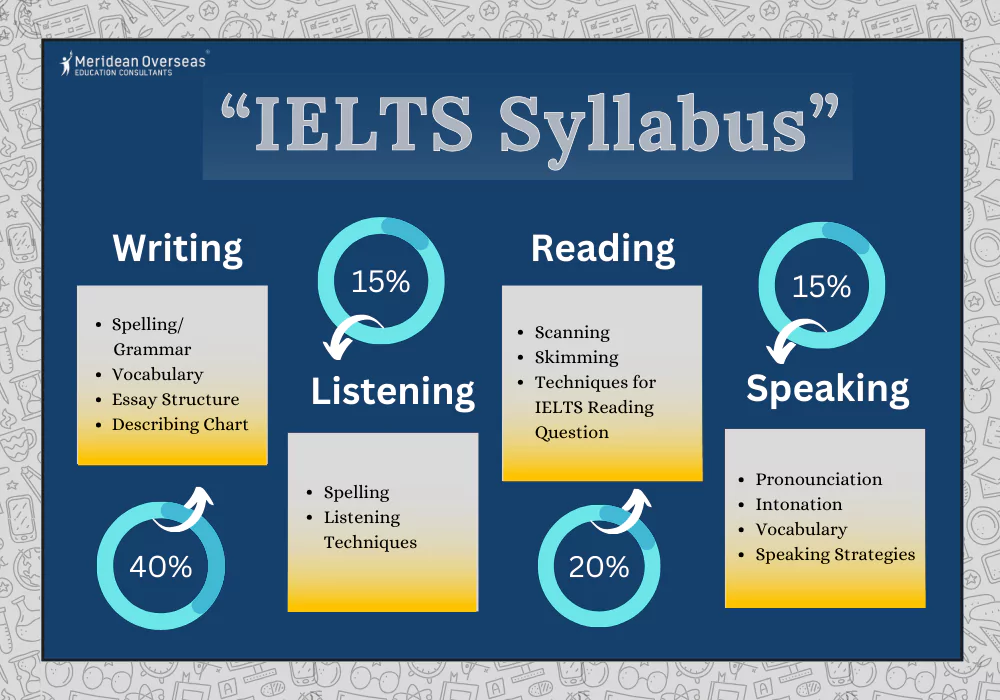
Announcements

Announcements

Are you looking to attain a good band score? If yes, you must start exploring the IELTS syllabus. The International English Language Testing System (IELTS) is available in Academic and General Training formats.
You must consider your requirements or your desired university prior to choosing one of the IELTS exams. The IELTS syllabus contains 4 parts: Speaking, Reading, Listening, and Writing.
Yet you must know that the syllabus of the Speaking and Listening sections are almost the same; the IELTS Exam Syllabus should be well-informed that both versions are instrumental in providing a valid and accurate assessment of your skills. The IELTS test duration is 2 hours and 45 minutes.

Section-wise IELTS Exam Syllabus
Highlights of the IELTS Exam Pattern 2025
IELTS Writing Section
IELTS Reading Section
IELTS Listening Section
IELTS Speaking Section
Preparation Tips for IELTS
FAQs
Here, let’s start looking at the IELTS Syllabus 2025 in detail. We will begin breaking down the syllabus section-wise, i.e. Reading, Speaking, Writing and Listening.
The IELTS Test syllabus for the Listening and Speaking sections is quite the same, whereas the syllabus for the Reading and Writing sections differs in IELTS Academic and IELTS General. Below, the IELTS Syllabus is broken down into 4 sections:
Writing syllabus
Reading syllabus
Listening syllabus
Speaking syllabus
Wait, before exploring the IELTS Exam Syllabus section-wise, take a look at its basic highlights.
|
Section |
Description |
Questions/Duration |
|
Listening |
Four recorded monologues and conversations. |
4 30 minutes |
|
Reading |
Three long reading passages with tasks. Texts range from descriptive to analytical. |
40 60 minutes |
|
Writing |
A writing task of at least 150 words and another short essay task of at least 250 words. |
2 60 minutes |
|
Speaking |
Face-to-face interview with three parts: Personal Interview, Long Turn, and Discussions. |
3 11 to 14 minutes |
The Writing section of the IELTS exam assesses your ability to communicate effectively in writing. It consists of two tasks, each with its own set of challenges. Let's explore the tasks in more detail:
In the academic version of IELTS Writing Task 1, you are presented with visual data such as graphs, charts, tables, or diagrams. The intent is to describe and interpret the information in their own words. This task evaluates your ability to convey information accurately and concisely.
For instance, you might be given a bar chart representing the population growth in different countries over a period. In response, they must highlight the key trends, make comparisons, and articulate the significance of the data.
In the general training version of Task 1, you must write a letter based on a given situation. The situations can vary, from writing a formal letter to a potential employer to composing a semi-formal letter to a colleague. This task assesses your ability to convey information in a specific tone and style appropriate for different contexts.
For instance, you might be asked to write a letter to a local newspaper expressing your opinion on an issue, or you might need to draft a letter to a friend inviting them to an event.
Task 2 in both versions of IELTS Writing involves writing an essay. You are presented with a point of view, argument, or problem and are expected to provide a well-structured and coherent response. The essay should be at least 250 words long.
For example, you might be asked to discuss the pros and cons of a particular technological development, express your opinion on a social issue, or analyse a given argument.
Time Management: Allocate your time wisely between Task 1 and Task 2. Task 2 carries more weight, so plan to spend more time on it.
Practice Writing Essays: Regularly practise writing essays on various topics to improve your ability to articulate ideas coherently within the time constraints.
Expand Your Vocabulary: Enhance your vocabulary to express ideas precisely. Avoid repetitive language and strive for variety.
Understand the Question: Take the time to fully understand the requirements of each task before you begin writing. Misinterpreting the question can result in a lower score.
Proofread: Allocate a few minutes at the end to proofread your writing. Correct any grammatical errors and ensure that your ideas flow logically.
Focusing on these tips can enhance your performance in the IELTS Writing section, ultimately improving your overall band score.

Now, let's move on to an in-depth exploration of the IELTS Reading Section. It is tailored to evaluate your ability to understand written information in an academic or general training context. It consists of three long passages, each with a set of questions to test various reading skills.
The Reading section's academic version includes complex texts suitable for those applying to higher studies or pursuing professional registration. These texts are often taken from academic journals, books, or research papers.
You might encounter passages discussing scientific research, historical developments, or analytical essays. The questions require a deep understanding of the text, and tasks can range from identifying information to summarising main ideas.
The reading passages in the general training version are more straightforward and accessible to a broader audience. The texts are typically taken from everyday sources such as advertisements, company guidelines, or brochures.
You might encounter passages related to workplace scenarios, travel information, or general topics of interest. The questions assess the ability to locate specific details, understand main ideas, and make inferences.
Skim and Scan: Practise skimming through a passage quickly to grasp the main ideas and scanning for specific details when answering questions.
Time Management: Allocate time strategically for each passage. Only spend a little bit of time on one.
Read the Questions First: Glance through the questions before reading the passage. This skimming through questions helps you focus on relevant information while reading.
Expand Vocabulary: A strong vocabulary aids in understanding complex passages. Learn and practice using a variety of academic and general vocabulary.
Practice Regularly: Familiarise yourself with different types of passages and question formats by practising regularly with sample papers.
By following these tips, you can develop effective reading strategies and improve your performance in the IELTS Reading section.
Next, let's delve into the IELTS Listening Section. The Listening section of the IELTS exam assesses your ability to understand spoken English in various contexts. It is divided into four sections, each presenting different types of spoken material.
In these sections, you encounter conversations related to daily life. Section 1 typically features a conversation between two people, while Section 2 involves a monologue set in an everyday social context.
For instance, Section 1 might have a dialogue between a customer and a shopkeeper, while Section 2 could be a monologue about local events.
Sections 3 and 4 shift the focus to more formal contexts related to education and training. Section 3 involves a conversation among multiple people, often students and a tutor, set in an educational context. Section 4 features a monologue on an academic subject.
For example, Section 3 might include a discussion among students planning a group project, while Section 4 could be a lecture on a scientific topic.
Various question types are used in the Listening section, including multiple-choice, short-answer questions, note completion, sentence completion, and labelling a diagram.
Practise Active Listening: Train yourself to actively listen for crucial details, main ideas, and specific information while hearing the recordings.
Predict Answers: Anticipate what the answer might be based on the context and information provided. This prediction can help you stay focused during the listening tasks.
Note-Taking: Use the provided time before each section to glance through the questions and briefly note what to listen for.
Check Spelling: Be cautious about spelling when writing answers. Incorrect spelling can result in losing marks.
Focus on Different Accents: Familiarise yourself with various English accents, as the recordings may feature speakers from different regions.
By incorporating these tips into your preparation, you can enhance your listening skills and perform well in the IELTS Listening section.
Now, let's move on to an in-depth exploration of the IELTS Speaking Section. It’s a face-to-face interview that assesses your ability to communicate effectively in spoken English. It consists of three parts:
In the first part, the examiner introduces themselves and asks you to talk about familiar topics such as family, home, studies, hobbies, and interests. This segment assesses your ability to provide personal information and casually converse.
You should be prepared to answer questions like "Tell me about your hometown" or "What do you enjoy doing in your free time?"
You will receive a task card with a topic in the second part. You will have one minute to prepare and make notes before speaking on the given topic for two minutes. After you finish your speech, the examiner may ask a few follow-up questions about the topic.
For example, the task card might instruct you to describe a memorable event or discuss a social issue.
The third part involves more profound questions and abstract discussions based on the topic from Part 2. The examiner and you will now engage in a more extended conversation where you can express opinions, elaborate on ideas, and handle complex language structures.
You might be asked to discuss broader issues, such as the impact of technology on society or the role of education in personal development.
Practice Speaking English Regularly: Engage in conversations in English with friends, language partners, or through language exchange platforms to build fluency.
Expand Vocabulary: Use a diverse range of vocabulary to express ideas clearly. Avoid repeating the exact words and phrases.
Stay Calm and Confident: Nervousness is natural, but maintaining composure and speaking confidently can positively impact your performance.
Listen Carefully to Questions: Ensure you understand the questions before responding. If needed, ask for clarification.
Use Examples and Details: Support your answers with relevant examples and details to showcase your language proficiency.
Incorporating these tips into your preparation routine can enhance your speaking skills and perform well in the IELTS Speaking section.
Preparation is vital to achieving a high band score in the IELTS exam. Whether opting for self-study or attending coaching classes, you can follow these tips:
Assess Language Proficiency: Understand your current level of English proficiency to tailor your preparation accordingly.
Set a Study Schedule: Plan a study schedule that allows consistent practice in all four exam sections.
Use Authentic Materials: Practice with authentic IELTS materials, including past papers and sample tests, to familiarise yourself with the format.
Simulate Test Conditions: Practice under timed conditions to simulate the actual exam environment and improve time management.
Focus on Weak Areas: Identify and work on areas where you feel less confident, whether reading comprehension, writing essays, or speaking fluently.
Seek Feedback: If possible, seek feedback from teachers, tutors, or language partners to understand areas of improvement.
Stay Informed: Keep up-to-date on any changes to the IELTS exam pattern, question formats, or scoring criteria.
Regularly Review Progress: Track your progress by regularly reviewing your performance in practice tests and adjusting your study plan accordingly.
By following these preparation tips, you can build the skills and confidence needed to perform well in the IELTS exam.
1. What is there in the IELTS Academic Writing Paper?
IELTS Writing consists of two tasks, and you will not have any choice; you have to complete both tasks. In Task 1, you must describe visual information in your own words. In Task 2, you'll be provided with an argument, problem, or point of view that requires discussion.
2. What is included in the IELTS Academic Reading test?
The IELTS Academic Reading test consists of three long passages with tasks. These passages cover various topics and are sourced from authentic materials such as books, journals, and newspapers. The content varies from descriptive and factual to discursive and analytical. Additionally, the passages may include non-verbal elements like diagrams and graphs.
3. What is there in the IELTS Speaking test?
The IELTS Speaking test comprises three parts. In the first part, there is an introduction and interview where candidates answer questions about familiar topics such as family, home, studies, hobbies, and interests. The second part involves a long turn, where candidates are given a topic on a task card and speak for two minutes after one minute of preparation. The third part consists of discussions based on the topic from the second part, allowing candidates to delve into deeper issues and explore their opinions.
4. What is there in the IELTS Listening Test?
The IELTS Listening test is divided into four sections. The first two sections focus on everyday social situations, including conversations and monologues. The last two sections shift to educational and training contexts, featuring conversations and monologues related to academic subjects. Various question types include multiple-choice, short-answer questions, note completion, sentence completion, and diagram labelling. The listening material, including monologues and dialogues, is played only once, and candidates must answer questions based on what they hear.
5. How do I change the Speaking test date?
You are required to contact the test centre directly or log in to the official IELTS registration portal to change the IELTS Speaking test date. Changes are subject to availability and may involve fees.
6. What will happen if I cannot attempt the IELTS test?
If unable to take the test, inform the test centre promptly. Options may include rescheduling, subject to centre policies and valid documentation. Refund and rescheduling rules vary, so refer to official IELTS guidelines for accurate information.

Contact MOEC Experts for Study Abroad Guidance!

MOEC